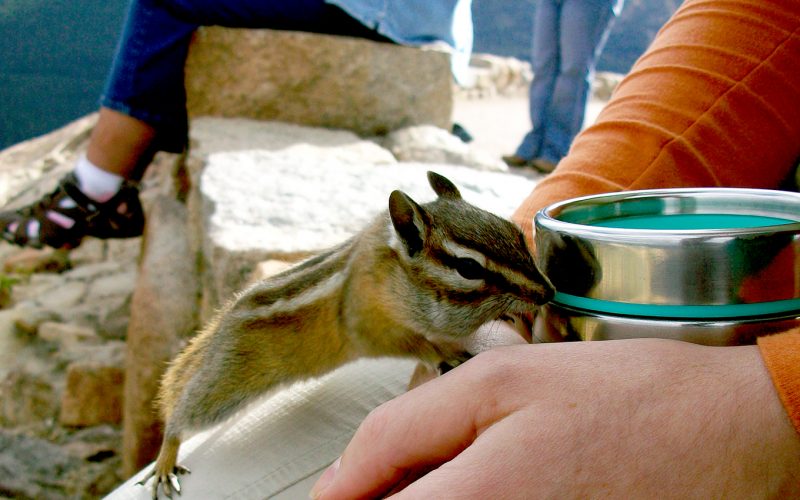
Photo Courtesy of Ryan Bancroft
A chipmunk sniffs a coffee thermos and engages the attention of tourists. Even though their cheek pouches are cute, it’s not a good idea to feed wildlife human food.
Chipmunks are inquisitive little animals known for their unique high-pitched singing abilities…no wait, not those Chipmunks. Our own native chipmunks are not world-famous for their rock ‘n’ roll records, but they can certainly claim fame for being cute and having gigantic cheek pouches.
Even though a chipmunk can gather 165 acorns in one day, foods like nuts and seeds aren’t the only things they store in their cheeks. They also pack in dirt from burrow excavation and relocate it to another location to make the entrance to their homes less visible. They live in rocky woodlands, and you may have seen them popping out of rock walls around Northwest Arkansas or at Devil’s Den State Park.
There are 24 species of chipmunk in North America, and one species (the Siberian chipmunk) found in Asia. Chipmunks are omnivores, not only consuming plant material but also small frogs, insects, and eggs. In our local ecosystems, chipmunks help to disperse seeds that turn into saplings, and aid in the reproduction of certain kinds of truffles which co-evolved with mushroom-eating mammals and can no longer disperse their spores through the air. Of course, chipmunks are a great food source for our native predators, and these rodents have many enemies: bobcats, snakes, weasels, foxes, hawks, and more.
Mating can occur once or twice a year depending on the species, and litters contain typically four to five young. They may live about a decade in captivity, but only live on average three years in the wild.
Did your cat or dog drag in a chipmunk to show you their awesome hunting skills? You might be able to save it if it does not appear injured. Look for bleeding, odd behavior, limping or obvious wounds. If you notice anything severe, call one of our awesome local wildlife rehabilitators and arrange to get the chipmunk to them as soon as possible. Morning Star Wildlife Rehabilitation in Gravette can help. Call Lynn at (479) 795-1515.
But if the chipmunk seems unscathed and is just in shock (not moving much, not running away from you, eyes not fully open, huddled up, sleepy) then gently place it on a towel inside a cardboard box or plastic bin, making sure to provide tiny air holes. Put the box on top of a heating pad, hot water bottle, or microwavable dried corn or rice pack. Check on it frequently to make sure it’s not getting worse or escaping, and keep it in a safe location for several hours or overnight. Fortunately, chipmunks are diurnal (active during the day) and will sleep at night, allowing you to get some rest too. It should soon perk up and you can release it back into the wild.
The next time you see or hear a chipmunk calling, listen carefully. New research indicates that chipmunks (and some other animals) may have distinct warning calls for aerial vs. ground predators. Chipmunks are clever rodents that are wonderful to watch, if you’re fast enough to spot one!
Amanda Bancroft is a Master Naturalist and volunteers with her husband Ryan for their solar-powered online educational center on how to make a difference with everyday choices at: www.RipplesBlog.org.










